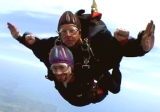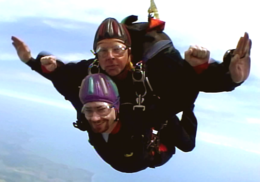
Tandem skydiving
Encyclopedia


Parachuting
Parachuting, also known as skydiving, is the action of exiting an aircraft and returning to earth with the aid of a parachute. It may or may not involve a certain amount of free-fall, a time during which the parachute has not been deployed and the body gradually accelerates to terminal...
where a student skydiver is connected via a harness to a tandem instructor. The instructor guides the student through the whole jump from exit through freefall
Free-fall
Free fall is any motion of a body where gravity is the only force acting upon it, at least initially. These conditions produce an inertial trajectory so long as gravity remains the only force. Since this definition does not specify velocity, it also applies to objects initially moving upward...
, piloting the canopy
Canopy piloting
Canopy Piloting encompasses several disciplines, all involving the flight of a skydiving parachute either at high altitude or close to the ground."Swooping" is one form of canopy piloting and is a growing activity in the skydiving world...
, and landing. The student needs only minimal instruction before making a tandem jump. This is one of three commonly used training methods for beginning skydivers; the others being static line and Accelerated Freefall
Accelerated Freefall
Accelerated freefall is a method of skydiving training. This method of skydiving training is called "accelerated" because the progression is the fastest way to experience solo freefall, normally from 10,000 to 15,000 feet "Above Ground Level"...
(known as Progressive Freefall in Canada).
Tandem skydiving is a very popular training method for first time skydivers, but it is more expensive than a static line skydive
Static line
A static line is a fixed cord attached to a large, stable object. It is used for safety in construction andto open parachutes automatically for paratroopers and novice parachutists.-Use in parachuting:...
. It exposes first-time jumpers to skydiving with minimal expectations from the student. The training may consist of many of the activities performed by any skydiving student, for example, how to exit the aircraft, how to do maneuvers in freefall, and how to deploy the main canopy themselves. However, the tandem master remains primarily responsible for safe and timely parachute
Parachute
A parachute is a device used to slow the motion of an object through an atmosphere by creating drag, or in the case of ram-air parachutes, aerodynamic lift. Parachutes are usually made out of light, strong cloth, originally silk, now most commonly nylon...
deployment.
Although it is the exception, many have commented that during a tandem skydive they experienced nausea and the feeling of passing out, which starts after the canopy deployment (never occurs during freefall) and goes away immediately after landing. It is believed to be caused primarily by the incorrect adjustment of the tandem harness affecting blood flow (this rarely occurs with a solo harness) and is more likely if the individual is at the upper end of the weight limit.
Equipment
Tandem skydiving requires equipment with several differences from normal sport skydiving rigs. All modern tandem skydiving systems use a drogue parachuteDrogue parachute
A drogue parachute is a parachute designed to be deployed from a rapidly moving object in order to slow the object, or to provide control and stability, or as a pilot parachute to deploy a larger parachute...
, which is deployed shortly after leaving the plane in order to decrease the skydivers' terminal velocity. This is necessary for proper parachute deployment, lengthening the duration of the skydive, and allowing the skydivers to fall at the same speed as videographers. Tandem skydiving systems also use larger main parachutes (360 square feet and larger) to support the additional weight of two passengers. The FAA requires tandem parachute rigs to be equipped with a main and reserve parachute, as well as an automatic activation device
Automatic activation device
Automatic Activation Device in skydiving terminology refers to an electronic-pyrotechnic or mechanical device that automatically opens the main or reserve parachute container at a preset altitude or after a preset time....
(AAD), a safety device that automatically deploys the reserve parachute if it detects that the skydivers are still at freefall speed below a certain altitude.

